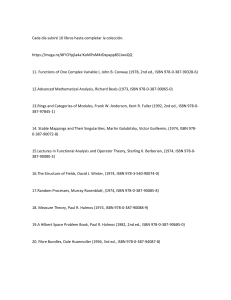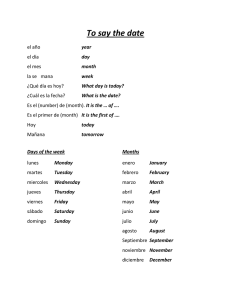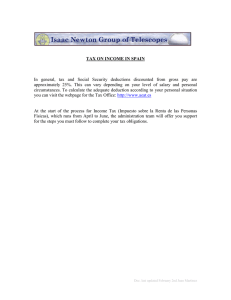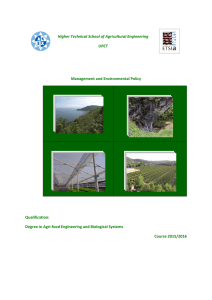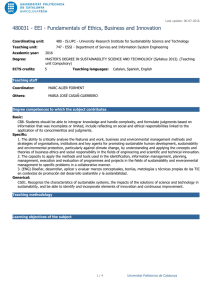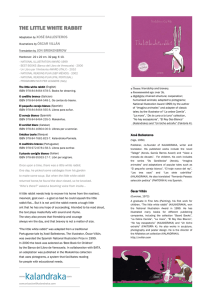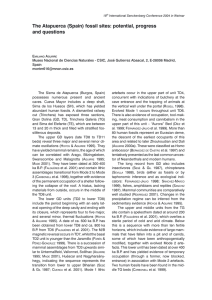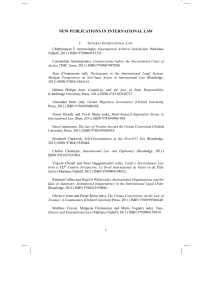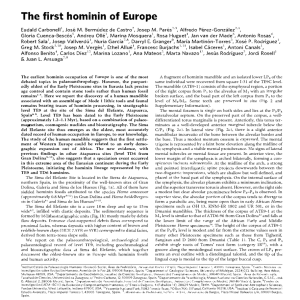26437 - VERTEBRATE AND HUMAN PALEOBIOLOGY
Anuncio
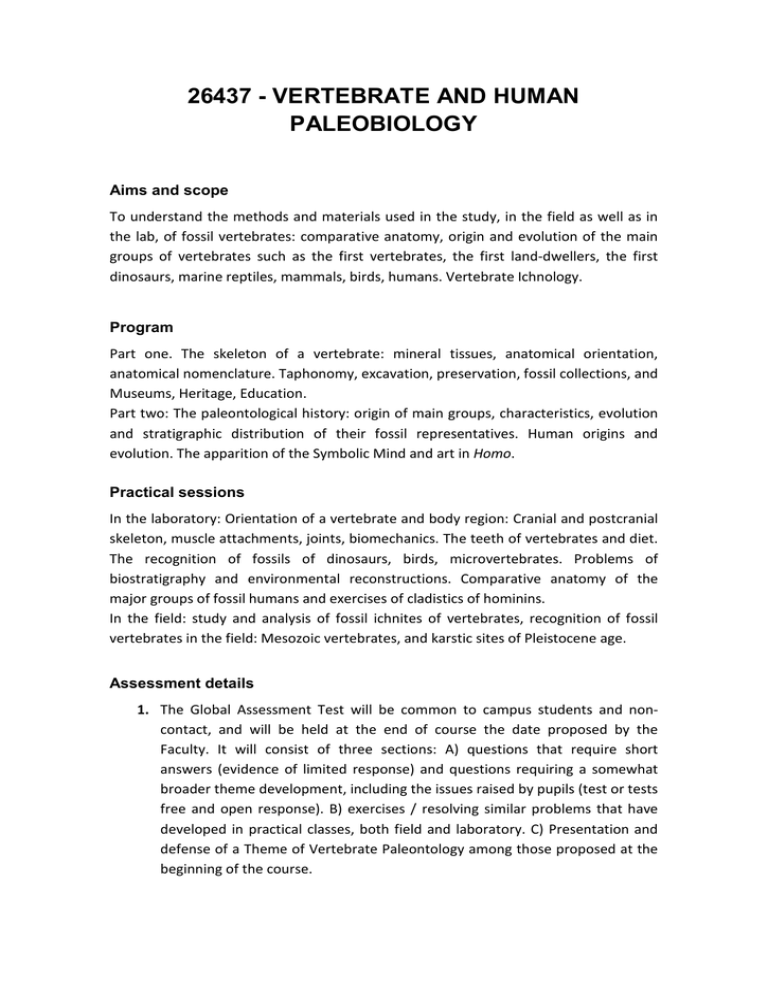
26437 - VERTEBRATE AND HUMAN PALEOBIOLOGY Aims and scope To understand the methods and materials used in the study, in the field as well as in the lab, of fossil vertebrates: comparative anatomy, origin and evolution of the main groups of vertebrates such as the first vertebrates, the first land-dwellers, the first dinosaurs, marine reptiles, mammals, birds, humans. Vertebrate Ichnology. Program Part one. The skeleton of a vertebrate: mineral tissues, anatomical orientation, anatomical nomenclature. Taphonomy, excavation, preservation, fossil collections, and Museums, Heritage, Education. Part two: The paleontological history: origin of main groups, characteristics, evolution and stratigraphic distribution of their fossil representatives. Human origins and evolution. The apparition of the Symbolic Mind and art in Homo. Practical sessions In the laboratory: Orientation of a vertebrate and body region: Cranial and postcranial skeleton, muscle attachments, joints, biomechanics. The teeth of vertebrates and diet. The recognition of fossils of dinosaurs, birds, microvertebrates. Problems of biostratigraphy and environmental reconstructions. Comparative anatomy of the major groups of fossil humans and exercises of cladistics of hominins. In the field: study and analysis of fossil ichnites of vertebrates, recognition of fossil vertebrates in the field: Mesozoic vertebrates, and karstic sites of Pleistocene age. Assessment details 1. The Global Assessment Test will be common to campus students and noncontact, and will be held at the end of course the date proposed by the Faculty. It will consist of three sections: A) questions that require short answers (evidence of limited response) and questions requiring a somewhat broader theme development, including the issues raised by pupils (test or tests free and open response). B) exercises / resolving similar problems that have developed in practical classes, both field and laboratory. C) Presentation and defense of a Theme of Vertebrate Paleontology among those proposed at the beginning of the course. 2. Multimedia presentation. Preparation of a bibliographic work on a specialized Vertebrate Paleobiology and/or Human topic. The report will be made individually, following the guidelines and the format that will be marked during the first seminar. The work will be exposed and defended by each student in the last seminars. This is to assess, through this activity their ability to explain and argue the points contained in the memory, and debate and discuss with other seminar participants (teachers and students). The time available for the presentation and defence of the topic during the seminar sessions will be 15 to 20 minutes. Students who pass the job will not need to develop this part of the overall test. 3. The labs and field sessions will be evaluated after a short report to be submitted by students after each practice. The report is the activity carried out during practice and the resolution of any cases proposed. 4. Evaluation criteria. The final note will be the mean from the test, the reports and the presentation of their bibliographic research. Bibliography Alexander, R.M. 1976. Estimates of speeds of dinosaurs. Nature 261, 129–30. Arsuaga, J. L. y Martínez, I. (1998) La Especie Elegida. Ediciones Temas de Hoy, Col. Tanto por Saber ISBN 978-84-7880-909-7 Arsuaga, J. L. (1999) El collar del Neandertal. Ediciones Temas de Hoy, Col. Tanto por Saber ISBN 978-84-7880-793-2 Arsuaga, J. L. (2002) Los aborígenes. RBA Libros ISBN 978-84-7901-932-7 Martínez, I. y Arsuaga, J. L. (2002) Amalur. Del átomo a la mente. Ediciones Temas de Hoy ISBN 978-84-8460-191-3 Arsuaga, J. L.; Bermúdez de Castro, J. M.; Carbonell, E. y Trueba, J. (2003) Los primeros europeos: Tesoros de la sierra de Atapuerca. Junta de Castilla y León ISBN 978-849718-143-3 Arsuaga, J. L. (2004) El mundo de Atapuerca. Plaza & Janés Editores ISBN 978-84-0137895-9 Arsuaga. J. L.; Martínez, I. y Trueba, J. (2004) Atapuerca y la evolución humana. Fundació Caixa Catalunya ISBN 978-84-89860-56-8 Arsuaga, J. L. (2006) La saga humana. Editorial Edaf ISBN 978-84-414-1821-9 Arsuaga, J. L. (2008) Mi primer libro de la prehistoria: Cuando el mundo era niño. Editorial Espasa ISBN 978-84-670-2938-2 Arsuaga, J. L. (2009) El reloj de Mr. Darwin. Ediciones Temas de Hoy ISBN 978-84-8460792-2 Arsuaga, J. L. (2010) Elemental, queridos humanos". Ediciones Temas de hoy. Ilustraciones de Forges Arsuaga, J. L. (2012) El primer viaje de nuestra vida. Ediciones Temas de Hoy ISBN 97884-9998180-2 Arsuaga, J. L. y Martín-Loeches, M. (2013) El sello indeleble. Pasado, presente y futuro del ser humano. Ediciones Debate, 424 págs. ISBN 9788499922485 Benton, M. J., Harper, D.A.T. 2009. Introduction to Paleobiology and the Fossil Record. Wiley-Blackwell, 605 pp. Benton, M.J. 2005 Vertebrate Palaeontology, third edition. Blackwell, 467 pp. Kielan-Jaworowska, Z., Cifelli, R.L. and Luo, Z.-X. (2004) Mammals from the Age ofDinosaurs: Origins,Evolution and Structure, Columbia University Press,New York. LIEBERMAN P., LAITMAN J.T., REIDENBERG J.S., GANNON P.J., 1992. The anatomy, physiology, acoustics and perception of speech: essential elements in analysis of the evolution of human speech. Journal of Human Evolution 23, 447-467. MARTÍNEZ, I., 2012. El primate que quería volar. Edit.: Espasa Libros S.L.U. MARTÍNEZ, I., ARSUAGA, J. L., QUAM, R., CARRETERO, J. M., GRACIA, A. y RODRÍGUEZ, L., 2008. Human hyoid bones from the middle Pleistocene site of the Sima de los Huesos (Sierra de Atapuerca, Spain). Journal of Human Evolution 54, 118-124. MARTÍNEZ, I., ARSUAGA, J.L., 2009. El origen del lenguaje: La evidencia paleontológica. Munibe, nº 60, pág. 5-16. MARTÍNEZ, I., ROSA, M., ARSUAGA, J. L., JARABO, P., QUAM, R., LORENZO, C., GRACIA, A., CARRETERO, J. M., BERMÚDEZ DE CASTRO, J., CARBONELL, E., 2004. Auditory capacities in Middle Pleistocene humans from the Sierra de Atapuerca in Spain. Proceedings of the National Academy of Sciences (USA) 101, 9976-9981. Polly PD, Eronen JT, Fred M, Dietl GP, Mosbrugger V, Scheidegger C, Frank DC, Damuth J, Stenseth NC, Fortelius M. 2011. History matters: ecometrics and integrative climate change biology. Proc Biol Sci. 2011 Apr 22;278(1709):1131-40. doi: 10.1098/rspb.2010.2233. TOBIAS, P. V., 1991. Olduvai Gorge, Volume 4. The Skulls, Endocasts and Teeth of Homo habilis. Cambridge University Press, Cambridge. Wallace, D.R. 2007. Neptune’s Ark, from Ichthyosaurs to Orcas. - Berkeley, University of California. Press. 282 pp. ISBN 978-0-520-24322-4. Webpages: www.aragosaurus.com
